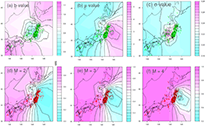** Progress in Earth and Planetary Science is the official journal of the Japan Geoscience Union, published in collaboration with its 50 society members.
Gallery View of PEPS Articles
Review
Solid earth sciences
202101202101
Visualizing heterogeneities of earthquake hypocenter catalogs: modeling, analysis, and compensation
Ogata Y
ABIC, Bias compensation, Detection rate function, Empirical Bayesian method, Data heterogeneity, Hypocenter catalogs, Location corrections, MAP solutions, Magnitude-shift, Smoothness constraints
Depth corrections of offshore earthquakes from the routinely determined JMA catalog by using hypocenters of F-net catalog, which can also be applied for future occurences.
Heterogeneity of spatio-temporal data. Parameter values of b-value distributions and detection rate functions obtained from aftershocks for the24h immediately following the Tohoku earthquake, and the percentage of earthquakes of, for example, M2, M3, and M4 that are detected 99.75% of the time.
As basic data for seismic activity analysis, hypocenter catalogs need to be accurate, complete, homogeneous, and consistent. Therefore, clarifying systematic errors in catalogs is an important discipline of seismicity research. This review presents a systematic model-based methodology to reveal various biases and the results of the following analyses. (1) It is critical to examine whether there is a non-stationary systematic estimation bias in earthquake magnitudes in a hypocenter catalog. (2) Most earthquake catalogs covering long periods are not homogeneous in space, time, and magnitude ranges. Earthquake network structures and seismometers change over time, and therefore, earthquake detection rates change over time and space. Even in the short term, many aftershocks immediately following large earthquakes are often undetected, and the detection rate varies, depending on the elapsed time and location. By establishing a detection rate function, the actual seismic activity and the spatiotemporal heterogeneity of catalogs can be discriminated. (3) Near real-time correction of source locations, far from the seismic observation network, can be implemented based on better determined source location comparisons of other catalogs using the same identified earthquakes. The bias functions were estimated using an empirical Bayes method. I provide examples showing different conclusions about the changes in seismicity from different earthquake catalogs. Through these analyses, I also present actual examples of successful modifications as well as various misleading conclusions about changes in seismic activity. In particular, there is a human made magnitude shift problem included in the global catalog of large earthquakes in the late nineteenth and early twentieth centuries.







